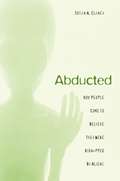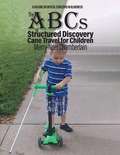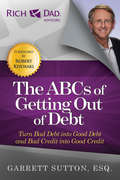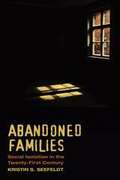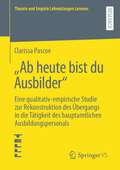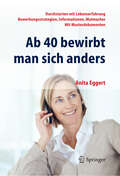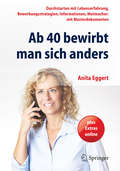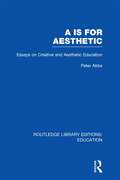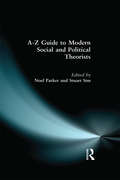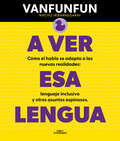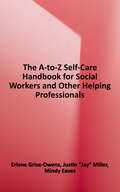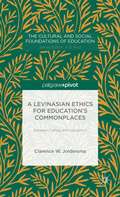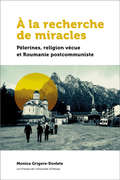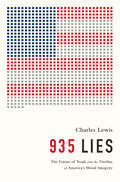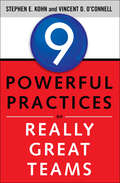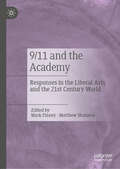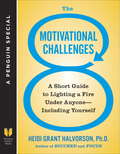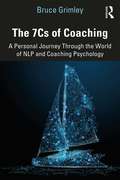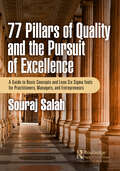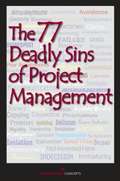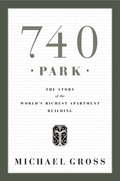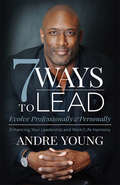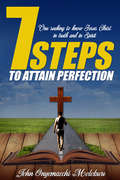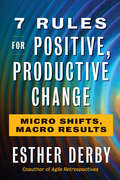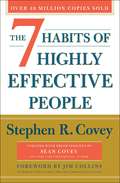- Table View
- List View
Abducted: How People Come to Believe They Were Kidnapped by Aliens
by Susan A. ClancyThey are tiny. They are tall. They are gray. They are green. They survey our world with enormous glowing eyes. To conduct their shocking experiments, they creep in at night to carry humans off to their spaceships. Yet there is no evidence that they exist at all. So how could anyone believe he or she was abducted by aliens? Or want to believe it? To answer these questions, psychologist Susan Clancy interviewed and evaluated "abductees"--old and young, male and female, religious and agnostic. She listened closely to their stories--how they struggled to explain something strange in their remembered experience, how abduction seemed plausible, and how, having suspected abduction, they began to recollect it, aided by suggestion and hypnosis. Clancy argues that abductees are sane and intelligent people who have unwittingly created vivid false memories from a toxic mix of nightmares, culturally available texts (abduction reports began only after stories of extraterrestrials appeared in films and on TV), and a powerful drive for meaning that science is unable to satisfy. For them, otherworldly terror can become a transforming, even inspiring experience. "Being abducted," writes Clancy, "may be a baptism in the new religion of this millennium." This book is not only a subtle exploration of the workings of memory, but a sensitive inquiry into the nature of belief.
The ABCs of Structured Discovery Cane Travel for Children (Critical Concerns In Blindness)
by Merry-Noel ChamberlainStructured Discovery Cane Travel (SDCT) is an Orientation and Mobility (O&M) curriculum which focuses on the foundational techniques necessary to develop future independence for students who are blind or visually impaired. The ABCs of Structured Discovery Cane Travel for Children addresses essential non-visual concept development, techniques and mobility skills needed to travel efficiently, gracefully and safely within a myriad of natural environments while using the long, white cane with a metal tip as the primary mobility tool. This curriculum utilizes transformational knowledge and problem-solving opportunities through teachable moments to develop personal reflection and mental mapping which can be utilized post instruction. These students maximize their cognitive intrinsic feedback while completing everyday mobility tasks. Parents and instructors of children who are blind or visually impaired will comprehend the essentials of SDCT by reading The ABCs of Structured Discovery Cane Travel for Children; in addition, they will receive a treasure trove of O&M skill-building activities.
The ABCs of Getting Out of Debt
by Garrett Sutton<p>In difficult times, debt can be a matter of life and death, happiness and despair. Controlling your debt can bring order and calm. Mastering debt can bring wealth and success. As bestselling Rich Dad/Poor Dad author Robert Kiyosaki says, “Good debt makes you rich and bad debt makes you poor.” <p>The ABCs of Getting Out of Debt provides the necessary knowledge to navigate through a very challenging credit environment. A Rich Dad’s Advisor and best selling author of numerous business books, Garrett Sutton, Esq. clearly writes on the key strategies readers must follow to get out of debt. Unlike other superficial offerings, Sutton explores the psychology and health effects of debt. From there, the reader learns how to beat the lenders at their own game, and how to understand and repair your own credit. Using real life illustrative stories, Sutton shares how to deal with debt collectors, avoid credit scams, and win with good credit.</p>
Abandoned Families: Social Isolation in the Twenty-First Century
by Kristin S. SeefeldtEducation, employment, and home ownership have long been considered stepping stones to the middle class. But in Abandoned Families, social policy expert Kristin Seefeldt shows how many working families have access only to a separate but unequal set of poor-quality jobs, low-performing schools, and declining housing markets which offer few chances for upward mobility. Through in-depth interviews over a six-year period with women in Detroit, Seefeldt charts the increasing social isolation of many low-income workers, particularly African Americans, and analyzes how economic and residential segregation keep them from achieving the American Dream of upward mobility. Seefeldt explores the economic and political obstacles that have altered the pathways for opportunity. She finds that while many low-income individuals work, enroll in higher education, and attempt to use social safety net benefits in times of crisis, they primarily have access to subpar institutions, which often hamper their efforts to get ahead. Many of these workers hold unstable, low-paying service sector jobs that provide few paths for advancement and exacerbate their social isolation. Those who pursue higher education to gain qualifications for better paying jobs often enroll in for-profit schools and online programs that push them into debt but rarely lead to secure employment or even a degree. And while home ownership was once the best way to establish wealth, Seefeldt finds that in declining cities like Detroit, it can saddle low-income owners with underwater mortgages in depopulated neighborhoods. Finally, she shows that the 1996 federal welfare reform and other retrenchments in the social safety net have made it more difficult for struggling families to access public benefits that could alleviate their economic hardships. When benefits are difficult to access, families often take on debt as a way of managing. Taken together, these factors contribute to what Seefeldt calls the “social abandonment” of vulnerable families. Abandoned Families is a timely, on-the-ground assessment of hardship in contemporary America. Seefeldt exposes the shortcomings of the institutions that once fostered upward mobility and shows how sweeping policy measures—including new labor protections, expansion of the social safety net, increased regulation of for-profit colleges, and reparations—could help lift up those who have fallen behind.
„Ab heute bist du Ausbilder“: Eine qualitativ-empirische Studie zur Rekonstruktion des Übergangs in die Tätigkeit des hauptamtlichen Ausbildungspersonals (Theorie und Empirie Lebenslangen Lernens)
by Clarissa PascoeIn diesem Buch wird der Übergang aus einer Tätigkeit als gewerblich-technische Fachkraft in die hauptamtliche Ausbildungsfunktion in einer betrieblichen Ausbildungswerkstatt untersucht. In einem fallrekonstruktiven Forschungsansatz wird das Erleben und Bewältigen von typischen Herausforderungen während und infolge dieses Übergangs nachgezeichnet. Hierzu wurden hauptamtliche Ausbilder*innen in den industriellen Metall- und Elektroberufen zu ihren Übergangserfahrungen befragt. Ergebnis ist eine empirisch fundierte Beschreibung von fünf typischen Entwicklungsaufgaben, mit denen Ausbilder*innen während und infolge des Übergangs konfrontiert werden und die sie in Abhängigkeit von subjektiven Ressourcen und Orientierungen unterschiedlich deuten und bearbeiten. Die Fallrekonstruktion führt zu vier Typen von Bewältigungsstrategien, die sich hinsichtlich ihres Umgangs mit Erfahrungswissen, ihrer pädagogischen Überzeugungen sowie ihres Reflexionswissens unterscheiden. Darauf aufbauend wird mit Hilfe des Sozialweltkonzeptes die Frage nach der Rolle und Funktion einer übergeordneten kollegialen Bezugsgemeinschaft als potentielle Wissens- und Kompetenzgrundlage der Akteure der beruflich-betrieblichen Bildung vor dem Hintergrund der strukturellen Rahmenbedingungen und Systemspezifika diskutiert.
Ab 40 bewirbt man sich anders. Durchstarten mit Lebenserfahrung - Bewerbungsstrategien, Informationen, Mutmacher - mit Musterdokumenten: Durchstarten Mit Lebenserfahrung  Bewerbungsstrategien, Informationen, Mutmacher  Mit Musterdokumenten
by Anita EggertAnlässe für Menschen ab 40, sich neu zu bewerben, gibt es viele: Eine Stellenanzeige reizt zu einem beruflichen Neustart, nach einer Erziehungspause steht der Wiedereinstieg an o. ä. Das Buch unterstützt Bewerber, indem es einen systematischen Überblick über alle Phasen gibt: von der Stellensuche über das Telefoninterview bis zum Bewerbungsgespräch. Die Autorin liefert die wichtigsten Tipps für eine zeitgemäße und korrekte Bewerbung sowie Hilfen, um zu einer selbstbewussten inneren Haltung zu finden. Begleitende Website mit Arbeitsmaterialien.
Ab 40 bewirbt man sich anders: Durchstarten mit Lebenserfahrung, Bewerbungsstrategien, Informationen, Mutmacher: mit Musterdokumenten
by Anita EggertEs gibt viele gute Gründe, sich mit ,,über 40" auf dem Arbeitsmarkt zu bewerben! - Doch vieles ist dann nicht mehr so selbstverständlich wie damals nach der Ausbildung und es tauchen Fragen auf: Wo finde ich eigentlich heutzutage Jobs? Wie bewerbe ich mich zeitgemäß? Wie bringe ich einen roten Faden in meinen Lebenslauf? Wie vermittele ich einen professionellen Eindruck? Anita Eggert begleitet Sie im Bewerbungsprozess und hilft Ihnen, eine selbstbewusste Einstellung zu entwickeln, Ihr Profil zu schärfen und einen erfolgreichen Schlachtplan zu entwickeln. Ihr Buch gibt Tipps für alle Phasen der Bewerbung, von der Stellensuche über das Telefoninterview bis zum Bewerbungsgespräch, liefert Fakten für eine individuelle, zeitgemäße und korrekte Bewerbung und Hilfen für ein überzeugendes Auftreten. - NEU in der 2. Auflage sind Infos zu Arbeitgeber-Bewertungsportalen im Internet, dem richtigen Outfit in Vorstellungsgesprächen sowie neuen Smartphone-Apps. Auf der begleitenden Website www. ab-40-bewirbt-man-sich-anders. de finden Sie stets aktuelle Infos und praktische Arbeitsmaterialien (Lebensläufe, Checklisten und ganze neu: Motivationsanschreiben etc).
Aa is for Aesthetic: Essays on Creative and Aesthetic Education (Routledge Library Editions: Education)
by Peter AbbsThis volume reaffirms the indispensable place of the arts in any coherent curriculum. The author hopes that the specific arguments formulated in the book will advance the conservationist post-Modernist aesthetic.
A-Z Guide to Modern Social and Political Theorists
by Noel Parker Professor Stuart SimThe A-Z Guide to Modern Social and Political Theories is a companion volume to the already published A-Z Guide to Modern Literary and Cultural Theorists. It ranges widely through the social sciences and related areas to identify thinkers who have had a major impact on the development of modern social and political theory and given clear, accessible summaries of their work. While the accent is on the later twentieth century, several up-and-coming theorists are included to ensure a contemporary edge to the volume, classic names in the field from the earlier twentieth century are not neglected, and the collection also delves back into the nineteenth century for such founding figures of the social sciences as Marx and Comte. The volume is therefore both up-to-date and mindful of the sources of modern debates.
A ver esa lengua: Cómo el habla se adapta a las nuevas realidades: lenguaje inclusivo y otros asuntos espinosos
by VanfunfunUsando palabras sencillas y argumentos de perroflauta punki de la lengua, defendidos por la lingüística más actual, este influencer de YouTube va a cambiar tu percepción de cómo se habla. ¡Hola! ¿Sabías que hablar mal es imposible? ¿Que la RAE no tiene la razón en muchas ocasiones? ¿Que el lenguaje inclusivo es bueno? ¿Que çe pue eccribî en andalû y no se acaba el mundo? ¿Y que, de hecho, la gente joven no está arruinando la lengua?
The A-to-Z Self-Care Handbook for Social Workers and Other Helping Professionals
by Erlene Grise-Owens Justin Jay" Miller Mindy EavesSelf-care is imperative for the ethical practice of social work and other helping professions. From A (awareness) to Z (ZZZZ--Sleep), the editors and contributors use a simple A-to-Z framework to outline strategies to help you build a self-care plan with specific goals and ways to reach them realistically. Questions for reflection and additional resource lists help you to dig deeper in your self-care journey. Just as the ABCs are essential building blocks for a young child's learning, you can use the ABCs in The A-to-Z Self-Care Handbook for Social Workers and Other Helping Professionals to build your way to a happy, healthy, ethical life as a helping professional. Includes a self-care planning form to help you set goals and formulate strategies.
a levinasian ethics for education’s commonplaces: between calling and inspiration
by To John NickJoldersma applies Levinas's ethics systematically to the commonplaces of education - teaching, learning, curriculum, and institutions - and elucidates the role of justice and responsibility and the meaning of calling and inspiration in education.
À la recherche de miracles: Pèlerines, religion vécue et la Roumanie postcommuniste (21e – Société, histoire et cultures)
by Monica Grigore-DovleteÀ la fin de l’année 1989, la Roumanie faisait son chemin vers la démocratie. Depuis, le pays connaît de nombreux changements, dont un renouveau religieux. Pourquoi la religion est-elle si présente en Roumanie postcommuniste ? Quels sont les impacts de cette présence accrue de la religion dans la société? C’est sur le terrain, dans des pèlerinages réalisés dans des monastères réputés pour leurs miracles, leurs confesseurs charismatiques et leurs reliques que l’auteure cherche des réponses à ces questions. En observant les croyances et les pratiques des pèlerines et des femmes au quotidien – et sans omettre la conduite des « porteurs de la religion officielle » –, le livre explore quatre thèmes qui constituent autant de facettes de la religion vécue : le sort, le charisme, la matérialité et les reliques. À travers ces thèmes, le livre brosse le tableau d’une religion quotidienne dans un contexte orthodoxe et propose une piste explicative sur le renouveau religieux en Roumanie après 1989, ainsi que des transformations sociales propres à la période postcommuniste. Publié en Français.
935 Lies: The Future of Truth and the Decline of America's Moral Integrity
by Charles LewisFacts are and must be the coin of the realm in a democracy, for government OC of the people, by the people and for the people, OCO requires and assumes to some extent an informed citizenry. Unfortunately, for citizens in the United States and throughout the world, distinguishing between fact and fiction has always been a formidable challenge, often with real life and death consequences. But now it is more difficult and confusing than ever. The Internet Age makes comment indistinguishable from fact, and erodes authority. It is liberating but annihilating at the same time. For those wielding power, whether in the private or the public sector, the increasingly sophisticated control of information is regarded as utterly essential to achieving success. Internal information is severely limited, including calendars, memoranda, phone logs and emails. History is sculpted by its absence. Often those in power strictly control the flow of information, corroding and corrupting its content, of course, using newspapers, radio, television and other mass means of communication to carefully consolidate their authority and cover their crimes in a thick veneer of fervent racialism or nationalism. And always with the specter of some kind of imminent public threat, what Hannah Arendt called OCyobjective enemies. OCOOCO An epiphanic, public comment about the Bush OC war on terrorOCO years was made by an unidentified White House official revealing how information is managed and how the news media and the public itself are regarded by those in power: OC You journalists live] OC in what we call the reality-based community. But] thatOCOs not the way the world really works anymore. WeOCOre an empire now, and when we act, we create our own reality . . . weOCOre historyOCOs actors . . . and you, all of you, will be left to just study what we do. OCO And yet, as aggressive as the Republican Bush administration was in attempting to define reality, the subsequent, Democratic Obama administration may be more so. Into the battle for truth steps Charles Lewis, a pioneer of journalistic objectivity. His book looks at the various ways in which truth can be manipulated and distorted by governments, corporations, even lone individuals. He shows how truth is often distorted or diminished by delay: truth "in time" can save terrible erroneous choices. In part a history of communication in America, a cri de coeur for the principles and practice of objective reporting, and a journey into several notably labyrinths of deception, "935 Lies" is a valorous search for honesty in an age of casual, sometimes malevolent distortion of the facts.
9 Powerful Practices of Really Great Teams
by Vincent D. O'Connell Stephen E. KohnIncreasingly, organizations count on project teams to develop products and deliver services to their customers. Consequently, effective teamwork and team leadership are integral components of an organization's success. In 9 Powerful Practices of Really Great Teams, Stephen E. Kohn and Vincent D. O'Connell define the essence of superior performance by project teams at work, and identify nine attributes of team membership and team leadership that set the stage for accomplishment of group objectives. Kohn and O'Connell bring these proven strategies to life with real-world examples drawn from decades of experience.
9/11 and the Academy: Responses in the Liberal Arts and the 21st Century World
by Mark Finney Matthew ShannonThis book explores the impact of September 11, 2001 upon interdisciplinary scholarship and pedagogy in the liberal arts. Since “the day that changed everything”, many forces have transformed institutions of higher education in the United States and around the world. The editors and contributors consider the extent to which the influence of 9/11 was direct, or part of wider structural changes within academia, and the chapters represent a wide range of interdisciplinary perspectives on how the production and dissemination of knowledge has changed since 2001. Some authors demonstrate that new forms of inquiry, exploration, and evidence have been created, much of it focused on the causes, consequences, and meanings of the terror attacks. Others find that scholars sought to understand 9/11 by applying old theoretical and empirical insights and reviving lines of questioning that have become relevant. The contributors also examine the impact of 9/11 on higher education administration and liberal arts pedagogies. Among the many collective findings is that scholars in the humanities and critical social sciences have been most attentive to the place of 9/11 in society and academic culture. This eclectic collection will appeal to students and scholars interested in the place of the liberal arts in the twenty-first century world.
The 8 Motivational Challenges
by Heidi Grant HalvorsonFrom the author of Succeed and Focus, a quick and easy guide to motivating anyone – including yourself. There is no one-size-fits-all way to get people motivated. Anyone who tells you that you should do X to get the most out of your employees, your students, or even yourself, isn’t telling you that – at best – X only works for some of the people, some of the time. In this short guide Heidi Grant Halvorson identifies the eight different types of underperformers and draws on research from her books Succeed and Focus to offer tailored strategies for lighting a fire under each one. Underperformers range from the truly achievement challenged to those who are actually performing at a high level but could perform even better if someone knew the right way to motivate them. Halvorson explains how we can understand each profile in terms of the mindset and motivational focus they bring to their work, in addition to the confidence with which they approach it. For each profile, each she lays out specific, evidence-based strategies for increasing effectiveness and engagement. Succinct and focused, this prescriptive guide will appeal to readers of What Successful People Do Before Breakfast and 9 Things Successful People Do Differently.
The 7Cs of Coaching: A Personal Journey Through the World of NLP and Coaching Psychology
by Bruce GrimleyIn The 7Cs of Coaching, Bruce Grimley expertly explains neuro-linguistic programming (NLP) to the advanced coach and counsellor by asking a simple question: 'What is NLP?'. Inviting us on his personal journey, he provides the reader in this book with an insight as to how he coaches using his own NLP model as well as exploring the complexity of NLP as a practice and why it tends to polarise opinion in today’s coaching landscape. Grimley insists that if the NLP paradigm is to find credible traction in the modern world, it needs to test its claims in the same way as other academic disciplines; based on his own research, this book does just that. Incorporating contemporary psychological understanding and neuroscientific research throughout, it provides a complete NLP model, outlining specific steps for the reader to follow in order to achieve excellence in coaching. It includes case studies, exercises and reflective questions which will encourage both novice and advanced coaches to explore the benefits of NLP, understanding and taking into account emotions and the unconscious mind in their practice. By analysing the NLP landscape, this book also addresses many issues which are shared by the broader coaching community such as differentiation from counselling, professional status and lack of a reliable empirical evidence base. Ground-breaking and thought-provoking, this book offers a modern examination of NLP. Highlighting why NLP is still useful and popular, and exploring why it fills a gap in the market place for effective coaching, this book will be essential reading for all coaches in practice and training, coach supervisors and counsellors with an interest in coaching techniques.
77 Pillars of Quality and the Pursuit of Excellence: A Guide to Basic Concepts and Lean Six Sigma Tools for Practitioners, Managers, and Entrepreneurs
by Souraj SalahThis book offers a basic and practical guide for a manager, quality practitioner, or anyone interested in learning and understanding the fundamental principles, concepts, tools, and techniques of quality management and process improvement. This book enables managers to have a strong foundation for effective management and improvement of operations. It strengthens quality practitioners’ approach to people, products, or services and process improvement, to influence without authority. It provides practitioners with a comprehensive understanding of the contemporary concepts of quality, guiding principles, and quality tools and techniques and on successfully implementing them. It helps enhance how practitioners perform their work and inspires them to strive for excellence.The book begins with an introduction and an overview of quality, followed by listing and explaining the selected 77 pillars (basic principles, concepts, and tools) of quality, grouped under the themes of quality, Six Sigma, and Lean Management. It examines the logical understanding of these pillars and how to implement them, providing practical examples and beneficial real case studies. The stories are based on the learning and practical experience of the author—a certified Lean Six Sigma Master Black Belt, a quality manager, and a university lecturer.This book benefits employees, partners, and customers of any organization, offering a great reference for practitioners and academics alike. It serves as a call to reflect on basic quality pillars first, before embarking on a quality improvement journey. It provides a solid foundation for managers and practitioners to exceed their customers’ expectations and excel in managing their business operations.
The 77 Deadly Sins of Project Management
by Management Concepts PressCombat the Deadly Sins of Project Management!Project management is a tough business. Not only must project managers contend with schedules, budgets, and a host of stakeholder demands, but they must also deal with sometimes vexing human behaviors, such as whining, indecision, opposition, inflexibility, complacency, and tunnel vision, to name a few. Projects can be negatively impacted by common "sins" that hinder, stall, or throw the project off track.In The 77 Deadly Sins of Project Management, the contributors focus on each "deadly sin" and probe its manifestations and consequences for projects. By sharing their personal experiences, as well as some historical events, the contributors spotlight the effects and costs — both financial and human — of failing to get a handle on these sins and reign them in. Through anecdotes and case studies, The 77 Deadly Sins of Project Management will help you better understand how to execute the myriad aspects of today's projects.• Identify danger signs and solutions for each "sin"• Learn proven methods for tackling project mishaps• Gain practical and hands-on information from seasoned professionals• Keep a variety of "sins" from derailing your projectBONUS! Each book comes with a "77 Deadly Sins of Project Management" poster!
740 Park: The Story of the World's Richest Apartment Building
by Michael GrossFor seventy-five years, it's been Manhattan's richest apartment building, and one of the most lusted-after addresses in the world. One apartment had 37 rooms, 14 bathrooms, 43 closets, 11 working fireplaces, a private elevator, and his-and-hers saunas; another at one time had a live-in service staff of 16. To this day, it is steeped in the purest luxury, the kind most of us could only imagine, until now. The last great building to go up along New York's Gold Coast, construction on 740 Park finished in 1930. Since then, 740 has been home to an ever-evolving cadre of our wealthiest and most powerful families, some of America's (and the world's) oldest money--the kind attached to names like Vanderbilt, Rockefeller, Bouvier, Chrysler, Niarchos, Houghton, and Harkness--and some whose names evoke the excesses of today's monied elite: Kravis, Koch, Bronfman, Perelman, Steinberg, and Schwarzman. All along, the building has housed titans of industry, political power brokers, international royalty, fabulous scam-artists, and even the lowest scoundrels.The book begins with the tumultuous story of the building's construction. Conceived in the bubbling financial, artistic, and social cauldron of 1920's Manhattan, 740 Park rose to its dizzying heights as the stock market plunged in 1929--the building was in dire financial straits before the first apartments were sold. The builders include the architectural genius Rosario Candela, the scheming businessman James T. Lee (Jacqueline Kennedy Onassis's grandfather), and a raft of financiers, many of whom were little more than white-collar crooks and grand-scale hustlers. Once finished, 740 became a magnet for the richest, oldest families in the country: the Brewsters, descendents of the leader of the Plymouth Colony; the socially-registered Bordens, Hoppins, Scovilles, Thornes, and Schermerhorns; and top executives of the Chase Bank, American Express, and U.S. Rubber. Outside the walls of 740 Park, these were the people shaping America culturally and economically. Within those walls, they were indulging in all of the Seven Deadly Sins. As the social climate evolved throughout the last century, so did 740 Park: after World War II, the building's rulers eased their more restrictive policies and began allowing Jews (though not to this day African Americans) to reside within their hallowed walls. Nowadays, it is full to bursting with new money, people whose fortunes, though freshly-made, are large enough to buy their way in. At its core this book is a social history of the American rich, and how the locus of power and influence has shifted haltingly from old bloodlines to new money. But it's also much more than that: filled with meaty, startling, often tragic stories of the people who lived behind 740's walls, the book gives us an unprecedented access to worlds of wealth, privilege, and extraordinary folly that are usually hidden behind a scrim of money and influence. This is, truly, how the other half--or at least the other one hundredth of one percent--lives.
7 Ways to Lead: Evolve Professionally & Personally
by Andre Young<p>A common sense guide to becoming a better leader and achieving a healthy work/life balance in order to live your best life.<p> <p>The number one complaint from many companies is “Our leaders don’t know how to lead!” Why would they? Most people are promoted because they did one thing really well or outlasted their “addicted to average” co-workers/teammates, not because they knew how to lead. Andre Young’s favorite example is “You sold a million dollars worth of product . . . You are now the Sales Manager.” They haven’t proved they can manage or lead anyone; they’ve only proven they can sell a million dollars worth of product . . . their way.<p> <p>Work/Life Harmony is more important now than it’s ever been. The notion of leaving home at the door before entering work and leaving work at the door when entering home is obsolete. The fact that cell phones are always accessible means significant others, relationships, and outside life now enter work with every employee . . . ALL DAY. So, when things are bad intimately, parentally, and socially, it shows up at work with employees trying to do their job in between responding to ten pages of “Hate Texts.” In contrast, when that same employee returns home, their phone may continue to ring with work emails, work texts, etc. If they respond, they’ve effectively communicated it’s okay to invade their time. If they don’t, it doesn’t erase the anxiety of not responding or knowing a pile of work is building up. There may not be a true balance between both realms, but 7 Ways to Lead helps leaders find and create harmony between the two.<p>
7 Steps to Attain Perfection: One seeking to know Jesus Christ in truth and in Spirit
by John Molokwu7 Steps To Attain Perfection, an embodiment of rudimentary guiding principles capturing the essence of being Born Again, was conceived out of a nurtured desire spanning 11 years of tuning and fine-tuning its contents to equip a believer with necessary steps taking them on a purposeful journey through life's unpredictable experiences. It begins the moment someone takes the decisive step to accept Christ as their Lord and Saviour to fulfilling their calling in God's vineyard. 7 Steps To Attain Perfection is equipped with biblical citations, anecdotes, and metaphorical connotations meant to expose your thoughts to new possibility of attaining perfection in Christ Jesus. It relates to every believer's struggle for acceptance and respect in a world of perverseness, deceitfulness, slothfulness, and actus reus. 7 Steps To Attain Perfection remains a great privilege for me having been inspired to tap from the wealth of wisdom, knowledge and understanding endowed by the Holy Spirit flowing through the ‘Still Small Voice' as I listened in the Spirit and penned down the Words as the Spirit gave me inspiration. Anyone applying the teachings in this book will transform their life through becoming changed for the better according to John 15:1-5.
7 Rules for Positive, Productive Change: Micro Shifts, Macro Results
by Esther DerbyChange is difficult but essential—Esther Derby offers seven guidelines for change by attraction, an approach that draws people into the process so that instead of resisting change, they embrace it. Even if you don't have change management in your job description, your job involves change. Change is a given as modern organizations respond to market and technology advances, make improvements, and evolve practices to meet new challenges. This is not a simple process on any level. Often, there is no indisputable right answer, and responding requires trial and error, learning and unlearning. Whatever you choose to do, it will interact with existing policies and structures in unpredictable ways. And there is, quite simply, a natural human resistance to being told to change. Rather than creating more rigorous preconceived plans or imposing change by decree, Agile software developer turned organizational change expert Esther Derby offers change by attraction, an approach that is adaptive and responsive and engages people in learning, evolving, and owning the new way. She presents a set of seven heuristics—guides to problem-solving—that empower people to achieve outcomes within broad constraints using their personal ingenuity and creativity. When you work by attraction, you give space and support for people to feel the loss that comes with change and help them see what is valuable about the future you propose. Resistance fades because people feel there is nothing to push against—only something they want to move toward. Derby's approach clears the fog to provide a new way forward that honors people and creates safety for change.Rather than creating more rigorous preconceived plans or imposing change by decree, Agile software developer turned organizational change expert Esther Derby offers change by attraction, an approach that is adaptive and responsive and engages people in learning, evolving, and owning the new way. She presents a set of seven heuristics—guides to problem-solving—that empower people to achieve outcomes within broad constraints using their personal ingenuity and creativity. When you work by attraction, you give space and support for people to feel the loss that comes with change and help them see what is valuable about the future you propose. Resistance fades because people feel there is nothing to push against—only something they want to move toward. Derby's approach clears the fog to provide a new way forward that honors people and creates safety for change.
The 7 Habits of Highly Effective People: 30th Anniversary Edition (The Covey Habits Series)
by Stephen R. Covey*New York Times bestseller—over 40 million copies sold* *The #1 Most Influential Business Book of the Twentieth Century* One of the most inspiring and impactful books ever written, The 7 Habits of Highly Effective People has captivated readers for nearly three decades. It has transformed the lives of presidents and CEOs, educators and parents—millions of people of all ages and occupations. Now, this 30th anniversary edition of the timeless classic commemorates the wisdom of the 7 Habits with modern additions from Sean Covey. The 7 Habits have become famous and are integrated into everyday thinking by millions and millions of people. Why? Because they work! With Sean Covey&’s added takeaways on how the habits can be used in our modern age, the wisdom of the 7 Habits will be refreshed for a new generation of leaders. They include: Habit 1: Be Proactive Habit 2: Begin with the End in Mind Habit 3: Put First Things First Habit 4: Think Win/Win Habit 5: Seek First to Understand, Then to Be Understood Habit 6: Synergize Habit 7: Sharpen the Saw This beloved classic presents a principle-centered approach for solving both personal and professional problems. With penetrating insights and practical anecdotes, Stephen R. Covey reveals a step-by-step pathway for living with fairness, integrity, honesty, and human dignity—principles that give us the security to adapt to change and the wisdom and power to take advantage of the opportunities that change creates.
